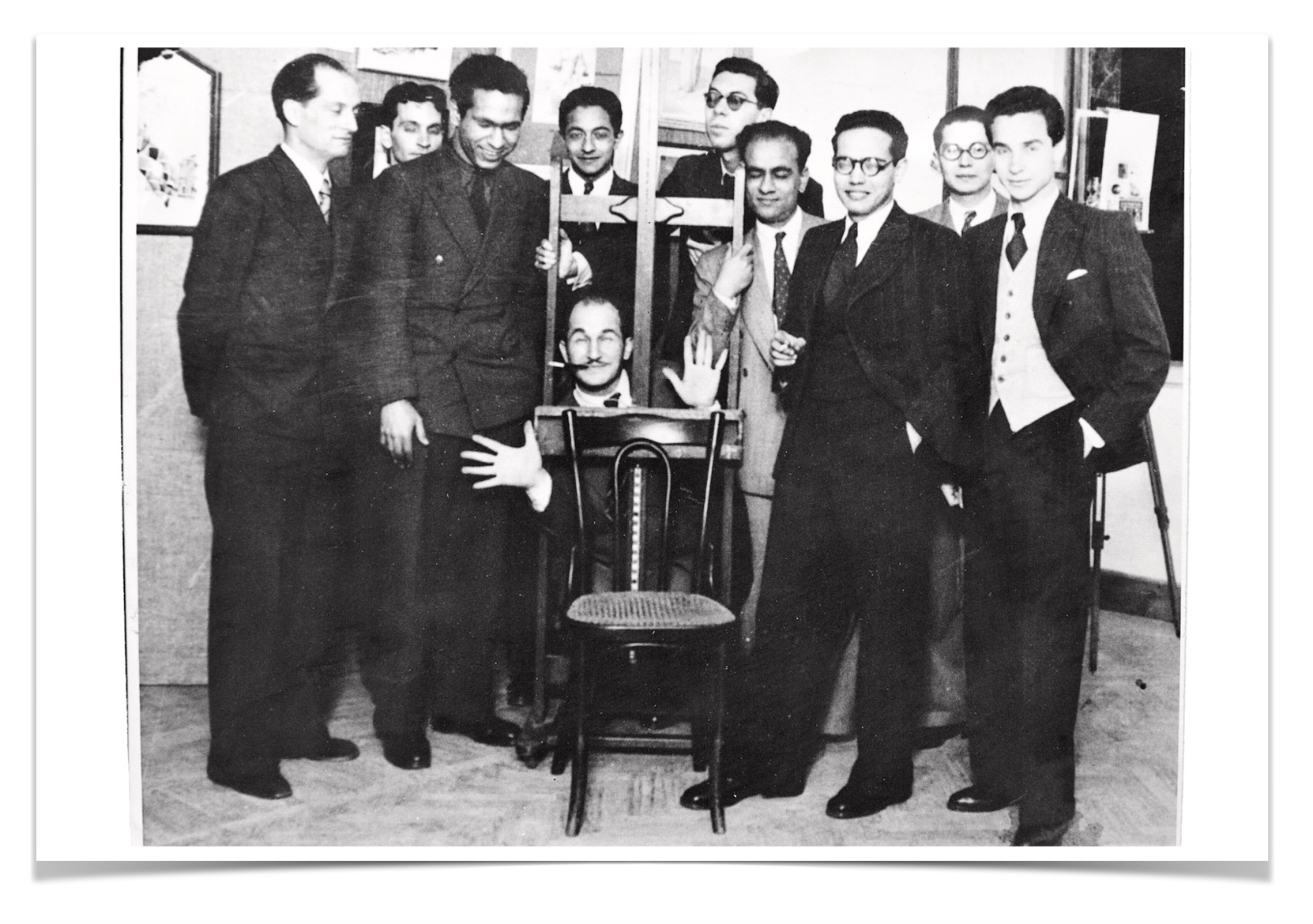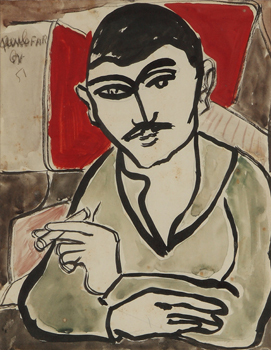Rupture, War and Surrealism in Egypt (1930s - 1940s)
September 28, 2016–January 9, 2017
Musée national d’art moderne—Centre Pompidou
Place Georges-Pompidou
75004 Paris
France
In 2017, the exhibition will travel to:
Kunstsammlung Nordrhein-Westfalen 20 (K 20)
Grabbeplatz 5
40213 Düsseldorf
Germany
Tate Liverpool
Albert Dock, Liverpool Waterfront
Liverpool L3 4BB
UK
www.centrepompidou.fr
www.kunstsammlung.de
www.tate.org.uk
Curated by Sam Bardaouil and Till Fellrath
About the exhibition
“In this hour, when the entire world cares for nothing but the sound of cannons, we have found it our duty to provide a certain artistic current with the opportunity to express its freedom and its vitality.”
–Opening statement from the catalogue of Art et Liberté’s first exhibition of independent art, February 8–24, 1940.
Baby Elephants Die Alone: Rupture, War and Surrealism in Egypt (1930s–1940s) is the first ever comprehensive museum exhibition of its kind about the Art and Liberty Group (Art et Liberté—jama’at al-fann wa al-hurriyyah), a surrealistically inclined, politically engaged artist and writer collective living and working in Cairo mostly from the late 1930s until the late 1940s. Initiated by the Musée national d’art moderne—Centre Pompidou, deputy director Catherine David has invited curators Sam Bardaouil and Till Fellrath to bring their ongoing research on the topic and work closely on developing this historic exhibition. Upon its conclusion in Paris, the exhibition will travel to the K20 in Dusseldorf and the Tate Liverpool.
Founded on December 22, 1938 upon the publication of the manifesto Long Live Degenerate Art, the Art and Liberty Group sought to instigate a rupture within their cultural and political milieu. Through their bulletin, entitled after the group's name, and their two periodicals, Don Quichotte and al-Tatawwur (Evolution), all published in 1939–40, the several works of prose and poetry they released through their two publishing houses Éditions Masses and La Part du Sable, and the numerous interventions and exhibitions of independent art that they mounted, including five seminal group shows between 1940 and 1945, Art et Liberté provided a generation of disillusioned Cairo-based Egyptian and non-Egyptian artists and writers, women as well as men, with a heterogeneous platform for cultural and political reform. Through their negotiation of Surrealism, the group sought to achieve a contemporary literary and pictorial language that was as much globally engaged as it was rooted in local artistic and political concerns. Art et Liberté rejected what they perceived as an imported academicism endorsed by a propaganda-seeking State/Monarchy, rebelled against an oppressive colonial power, and broke away from a conservative bourgeois morality that celebrated “art for art’s sake.” A decade later, not without scandal, several of the group’s members were already in prison or in exile. This, along with a formal letter dated July 26, 1948 from Georges Henein, one of the group's main protagonists, to André Breton declaring withdrawal from the Surrealist movement, signaled the beginning of the end. "Baby elephants die alone," Henein would declare years later when looking back at Art et Liberté's short-lived yet intense existence. In borrowing this statement for its title, and through the retelling of their remarkable story, this historic exhibition addresses the group's long lost, often misconstrued legacy. It explores at once the cultural and political background from which they emerged, as well as the impact they made on a younger generation of artists and writers who were to become some of the leading figures of Egyptian modernism over the decade that followed.
Five years in preparation, curators Sam Bardaouil and Till Fellrath have consolidated the findings of their extensive primary research and hundreds of field interviews conducted in Egypt and worldwide. They have selected around 200 paintings, works on paper, and photographs dating from the late 1920s until the early 1950s along with an extensive body of archival documents, historical photographs and primary manuscripts that have never been exhibited before. The traced artworks are carefully drawn from over 30 public and private collections coming from Egypt and 15 other countries. In reuniting these artworks and documents, this historic exhibition charts a precise chronology of Art et Liberté making for the first all-encompassing museum presentation of the group to date. The curators' ongoing research on the subject was introduced in their acclaimed international touring exhibition Tea with Nefertiti (2012–14) where they dedicated a chapter to Art et Liberté in the exhibition and its respective multi-lingual catalogue. The lack of accessible archival documentation is often cited as the main justification for the incomplete art-historical chronologies of modern art from the Arab world. The exhibition Baby Elephants Die Alone, along with its accompanying publications, addresses this gap by showcasing a large number of mostly unknown artworks and primary documents, making them available for the first time to art historians and the general public alike.
Set against the backdrop of the Second World War, the exhibition sheds light on Art et Liberté’s stand against the alignment of art and political propaganda. Moreover, it highlights the group's rejection of fascism, which beyond its firm grip over Europe, had been on the rise in Egypt since the early 1930s and was beginning to pose a highly-felt threat at home. The group’s entanglement with a complex network of diasporic artistic and literary hubs dispersed in cities as far-flung as Cairo, Beirut, Athens, Paris, London, New York, San Francisco, Fort-de-France, Mexico City, Santiago de Chile and Tokyo, just to name a few, challenges the regionalist approach to the study of modernity. These global networks and other aspects of Art et Liberté's literary and pictorial output will be explored, beyond the exhibition itself, through a number of public programs, academic symposia, forums of oral histories, film screenings and theatre productions.
Publications
A 450-page academic monograph on Art et Liberté authored by Sam Bardaouil and published by I.B.Tauris will be released. It will include a select anthology of literary works by various Art et Liberté members, transcriptions of rare primary documents, and a comprehensive visual inventory of artworks most of which have never been published before. The exhibition Baby Elephants Die Alone: Rupture, War and Surrealism in Egypt (1930s - 1940s) draws on the wider research that is covered within this book. Given its breadth of scope, this monogrpah will be the first exhaustive academic work of its kind on the art, as well as the literature, of Art et Liberté.
In conjunction with the exhibition, a fully-illustrated catalogue will be published in English, French, German and Arabic as separate editions, and will be available for international distribution.
For Art Reoriented publications on The Art and Liberty Group:
www.artreoriented.com/dada-surrealism-dirty-dark-loud-and-hysteric
www.artreoriented.com/publications
For more information: Art Reoriented, Munich / New York, info@artreoriented.com

